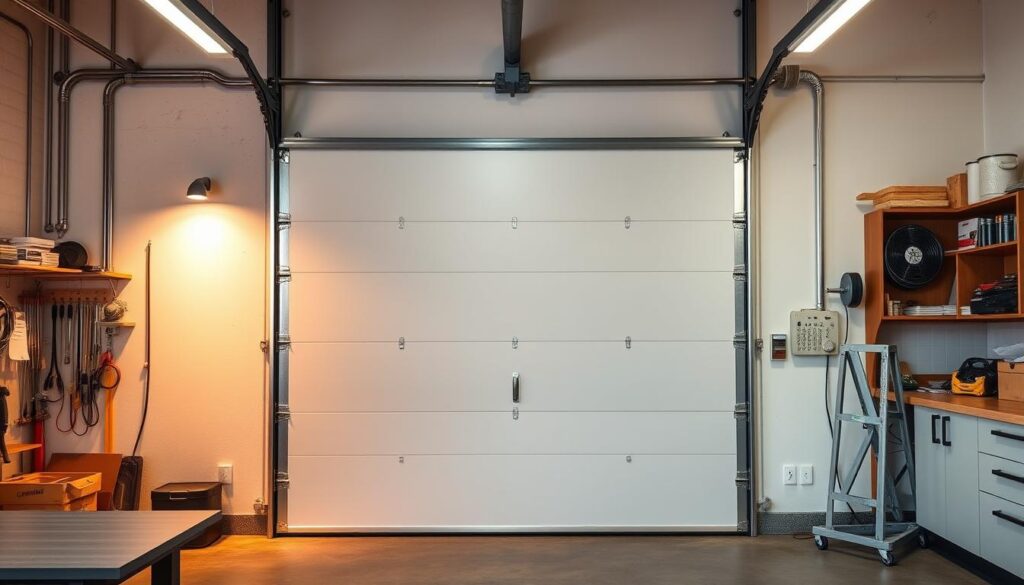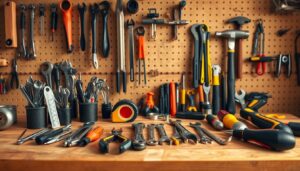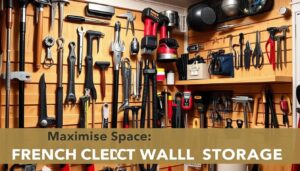Are you tired of the constant noise disrupting your peaceful workspace? Whether you’ve converted your garage into a music studio, a workshop, or a quiet retreat, a soundproof garage door can be a game-changer.
A standard garage door can be a significant source of noise leakage due to gaps, thin panels, or inadequate insulation. By soundproofing your garage door, you can keep the noise in and prevent external sounds from entering, thus enhancing your productivity and enjoyment of your workshop activities.
Key Takeaways
- Soundproofing your garage door can significantly reduce noise disturbance.
- A soundproof garage door enhances your workspace’s overall productivity.
- It allows for greater flexibility in working hours without disturbing others.
- Common issues with standard garage doors include gaps and thin materials.
- Effective soundproofing solutions can be applied to achieve a quieter workspace.
Why Soundproofing Your Garage Workshop Door Matters
Soundproofing is not just about keeping noise in; it’s also about creating a peaceful workspace. A soundproof garage workshop door can significantly impact your productivity and overall workshop experience.
Keeping Noise In: Protecting Your Neighbours
By soundproofing your garage door, you can contain the noise within your workshop, ensuring that it doesn’t disturb your neighbours or other family members. This consideration is not only polite but also helps in maintaining a good relationship with those around you.
Keeping Noise Out: Creating a Peaceful Workspace
External noise from traffic, neighbours, or weather can be a significant distraction. A properly soundproofed door creates a sanctuary-like environment that is conducive to focused work. The psychological benefits of working in a quiet, controlled acoustic environment are numerous, including enhanced creativity and enjoyment of workshop activities.
| Benefits of Soundproofing | Description |
|---|---|
| Improved Concentration | Reducing external noise enhances your ability to focus on tasks. |
| Increased Precision and Safety | Minimizing distractions when using power tools improves safety and precision. |
| Enhanced Creativity | A peaceful workspace fosters creativity and enjoyment in your work. |
Understanding Sound Transmission Through Garage Doors
Understanding the mechanics of sound transmission through garage doors is the first step towards achieving an effective soundproofing solution. Sound transmission occurs when sound waves pass through a barrier, in this case, your garage door.
Common Weak Points in Garage Doors
Most standard garage doors are not designed with soundproofing in mind, making them prone to sound leakage. Common weak points include gaps under the door and around the sides. These gaps allow sound waves to escape or enter, compromising your workshop’s soundproofing.
Addressing these weak points is crucial for effective soundproofing. By sealing gaps and improving the door’s overall construction, you can significantly reduce sound transmission.
How Sound Travels Through Different Door Materials
The material composition of your garage door plays a significant role in sound transmission. Different materials have varying abilities to block or absorb sound waves. For instance, solid wood doors tend to perform better than hollow metal doors due to their density and mass.
- The density and mass of door materials affect sound transmission; denser materials generally offer better soundproofing.
- Sound Transmission Class (STC) ratings provide a measure of a material’s ability to reduce sound transmission; higher STC ratings indicate better soundproofing performance.
- Multi-layered doors, which often include a combination of materials, can offer superior soundproofing compared to single-layer options.
- The internal structure of insulated doors, typically filled with materials like foam, can help reduce sound transmission by absorbing sound waves.
By understanding how different materials impact sound transmission, you can make informed decisions when selecting or upgrading your garage door to improve its soundproofing capabilities.
Assessing Your Garage Workshop Door
To achieve optimal soundproofing, you need to start by assessing the current state of your garage workshop door. This initial evaluation will help you identify areas that require improvement.
Identifying Gaps and Leaks
Begin by visually inspecting your garage door for any visible gaps or leaks. Check the door’s seals, weatherstripping, and the surrounding frame for any signs of wear or damage. You can use a simple test by holding a lit candle or incense stick near the suspected gaps; if the flame flickers or the smoke is drawn towards the gap, you’ve identified a leak.
- Inspect the door’s surface for any cracks or damage.
- Check the weatherstripping and seals for signs of wear.
- Look for any gaps between the door and the frame.
Testing Current Sound Levels
To effectively soundproof your garage, you need to establish a baseline for the current sound levels. You can use a decibel meter or a smartphone app to measure the noise levels inside and outside your workshop. A simple testing protocol involves operating common workshop tools and measuring the sound levels at different distances from the door.
- Use a decibel meter or smartphone app to measure sound levels.
- Operate workshop tools to simulate typical usage.
- Record the sound levels to compare with post-soundproofing measurements.
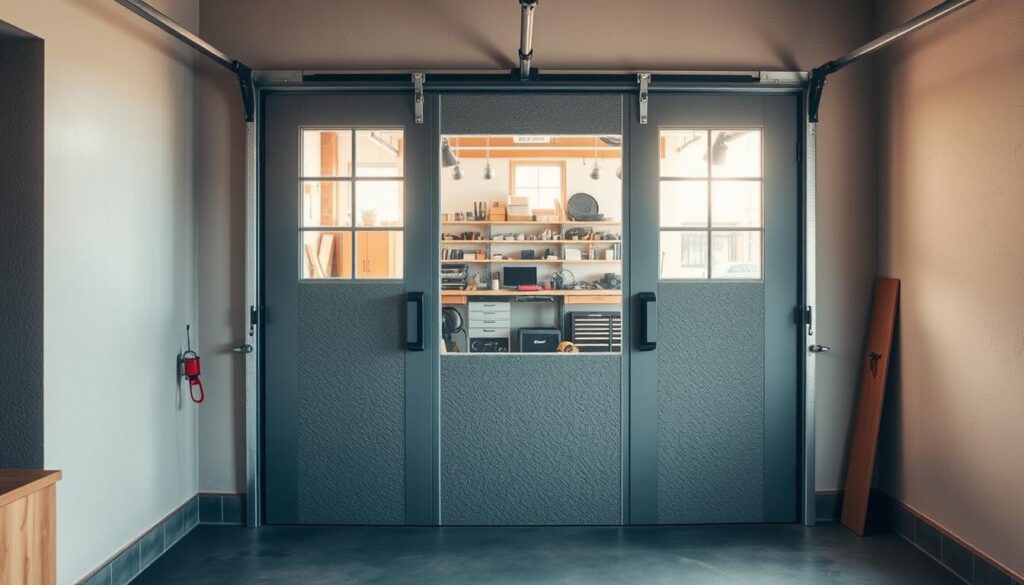
Essential Materials for a Soundproof Garage Workshop Door
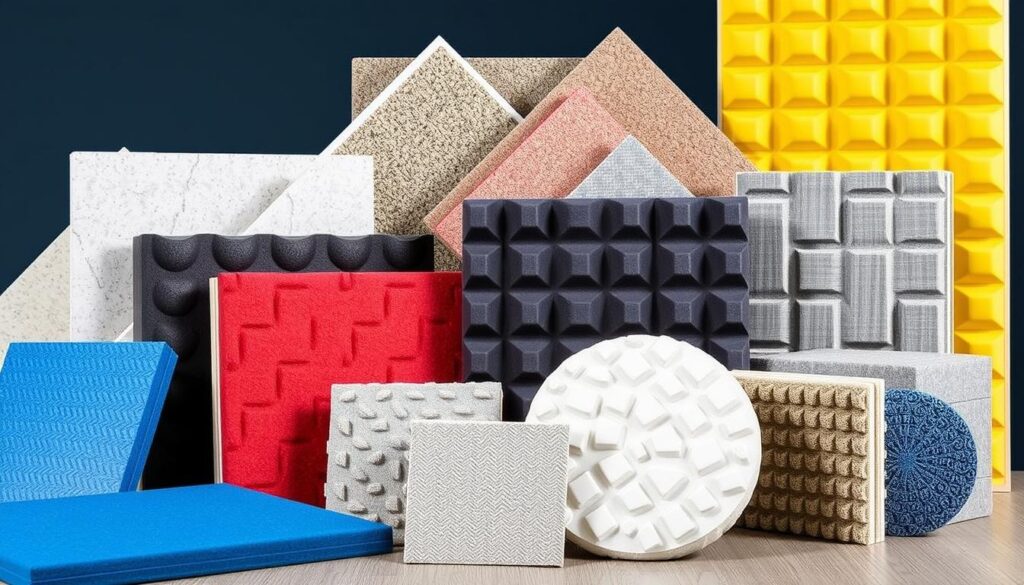
To effectively soundproof your garage workshop door, you’ll need to select the right materials. The right materials can significantly reduce noise transmission, creating a more peaceful workspace.
Seals and Weatherstripping Options
Seals and weatherstripping are crucial for filling gaps around your garage door. You can choose from various types, including rubber seals and weatherstripping tapes, to ensure a tight seal.
Acoustic Panels and Mass Loaded Vinyl
Acoustic panels absorb sound, reducing echo and noise transmission. Mass loaded vinyl is a flexible, thin material that can be applied to your garage door to enhance soundproofing.
Insulation Materials
Insulation materials like fibreglass, mineral wool, and foam board can be used to soundproof your garage door. Choosing the right insulation depends on your specific needs and the door’s construction.
When selecting insulation, consider the R-value for thermal benefits and the material’s density for sound absorption properties. Specialized acoustic insulation products are designed specifically for sound control.
Step-by-Step Guide to Soundproofing Your Garage Workshop Door
Soundproofing your garage door is a simple yet effective way to improve your workshop’s overall ambiance. By following a few straightforward steps, you can significantly reduce noise leakage and create a more productive environment.
Preparing Your Door Surface
Before you begin soundproofing, ensure your garage door is clean and dry. Remove any dirt, grime, or old adhesive that might interfere with the soundproofing materials. This preparation step is crucial for ensuring a strong bond between the door and the soundproofing elements.
Installing Door Seals and Weatherstripping
Door seals and weatherstripping are essential for preventing sound leakage around the edges of your garage door. Choose a suitable seal or weatherstripping that fits your door type and follow the manufacturer’s instructions for installation. This will help to create a tight seal, reducing sound transmission.
Adding Acoustic Panels to the Door
Installing acoustic soundproofing panels on the interior of your garage door can significantly reduce sound reflection and dampen external noise. These panels can be fabric-wrapped or made from foam and are easy to attach. When adding acoustic panels, consider the door’s hardware and windows to ensure a seamless installation.
You can attach acoustic panels using adhesives, mechanical fasteners, or a combination of both, depending on the type of garage door you have. Optimal placement patterns involve spacing the panels evenly to maximize sound absorption. Be sure to work around door hardware and structural elements without compromising the door’s operation or the panels’ effectiveness.
Sealing Gaps Around Your Garage Door
One of the most critical aspects of soundproofing your garage workshop is ensuring that the gaps around the door are properly sealed. Gaps around the garage door can significantly compromise your soundproofing efforts, allowing sound to escape or enter.
Bottom Seals and Threshold Options
The bottom seal is a crucial component in preventing sound leakage. You can choose from various types, including rubber seals and threshold seals. Stormstop multi-seals are versatile options that can be used to seal gaps effectively.
| Seal Type | Material | Effectiveness |
|---|---|---|
| Rubber Seal | Durable Rubber | High |
| Threshold Seal | Flexible Material | Very High |
Side and Top Seals
For the sides and top of the garage door, different types of seals are available, including compression seals, brush seals, and V-seals. Proper measurement and cutting are essential for precise corner joints. Compression seals are particularly effective for sealing gaps around the sides and top.
When installing these seals, consider the material of your door frame to ensure a secure fit. Addressing the junction points where seals meet is also crucial for maintaining soundproofing integrity.
Enhancing Door Soundproofing with Insulation
To further enhance your garage workshop door’s soundproofing, consider adding insulation. Insulation plays a crucial role in reducing sound transmission through your garage door. By choosing the right insulation materials, you can significantly improve the overall soundproofing of your workspace.
Foam Insulation Techniques
Foam insulation is a popular choice for soundproofing garage doors due to its ease of installation and effectiveness. You can use foam boards or spray foam to fill gaps and cavities in your garage door. Proper installation is key to ensuring that the foam insulation works effectively. Make sure to follow the manufacturer’s instructions for the best results.
Fibreglass and Mineral Wool Options
Fibreglass and mineral wool are other effective insulation materials for soundproofing. Fibreglass is a cost-effective option that can be easily installed in most garage doors. Mineral wool, on the other hand, offers superior sound absorption properties. When handling these materials, ensure you wear protective gear to avoid skin irritation and inhalation of fibres. As
“the density and thickness of insulation materials directly impact their sound absorption performance”
, choose materials that are dense and thick enough for optimal soundproofing.
Additional Workshop Soundproofing Measures
To further enhance your garage workshop’s soundproofing, consider additional measures beyond the door. While a soundproof garage door is crucial, other elements in your workshop can still let in unwanted noise or allow sound to escape.
Soundproofing Walls and Ceilings
Soundproofing your walls and ceilings is vital to creating a truly quiet workspace. You can achieve this by installing acoustic panels or mass-loaded vinyl on your walls and ceilings. These materials are designed to absorb sound, reducing echo and preventing noise from escaping.
Floor Soundproofing Solutions
Floor soundproofing is often overlooked but is equally important. Consider using soundproofing underlayment materials or installing a floating floor to reduce noise transmission through the floor.
Addressing Windows and Other Openings
If your garage has windows, installing acoustic window plugs can be an effective way to keep outdoor noises out. For other openings, such as vents, ensure you have proper soundproofing measures in place, like acoustic covers or plugs. This comprehensive approach to soundproofing will help you achieve a peaceful garage workshop.
Budget-Friendly Soundproofing Solutions
You can soundproof your garage workshop door without breaking the bank. Effective soundproofing doesn’t require expensive materials or professional installation. With a little creativity and some DIY effort, you can significantly reduce noise leakage and create a more peaceful workspace.
DIY Acoustic Panels and Barriers
Creating your own acoustic panels is a cost-effective way to enhance soundproofing. You can use affordable materials like Owens Corning 703 or Roxul Safe’n’Sound insulation, wrapped in fabric or other breathable materials. These panels can be hung on walls or placed strategically around your garage workshop to absorb sound and minimize echo. By making your own panels, you can save money and customize them to fit your space.
Repurposed Materials for Soundproofing
Repurposing old or discarded materials is another budget-friendly approach to soundproofing your garage. You can use old blankets, thick curtains, or even carpet remnants to create DIY soundproofing solutions. For instance, hanging thick curtains or blankets over windows and doors can help absorb sound. If you’re on a super tight budget, consider visiting your local charity shop for discounted curtains or blankets. By getting creative with repurposed materials, you can effectively reduce noise without spending a fortune on your garage workshop.
Testing Your Soundproof Garage Workshop Door
Verifying the soundproofing of your garage workshop door through testing is a vital step. This process ensures that your efforts have been effective in reducing noise leakage.
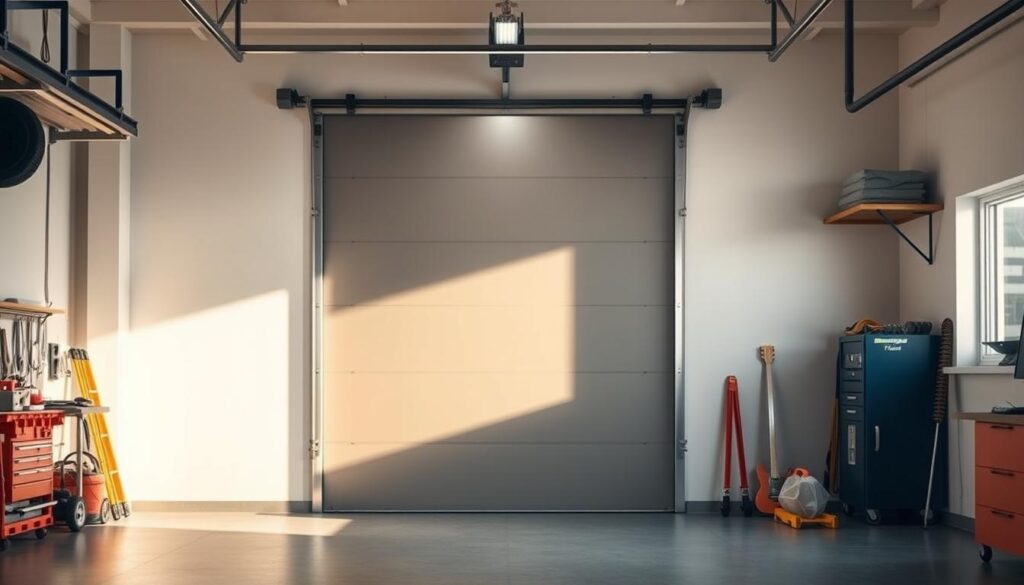
Before and After Sound Measurements
To accurately assess the performance of your soundproofing efforts, take sound measurements before and after the installation. Use a sound level meter to record decibel levels both inside and outside your garage. Compare these readings to determine the effectiveness of your soundproofing. For more detailed information on sound measurement techniques, you can refer to resources such as the government publication on noise standards.
Fine-Tuning Your Soundproofing
If the initial test reveals that the soundproofing is not meeting your expectations, identify the weak points and address them. Check for any gaps or leaks around the door and reseal them if necessary. You may need to add additional acoustic panels or adjust the existing ones to achieve the desired level of soundproofing. As “soundproofing is not a one-size-fits-all solution”, be prepared to make adjustments based on your specific needs.
By following these steps, you can ensure that your garage workshop door is effectively soundproofed, providing a quieter workspace and reducing noise disturbance to neighbours.
Maintenance Tips for Your Soundproofed Door
To keep your soundproofed garage door functioning effectively, regular maintenance is crucial. This involves checking and maintaining the door seals and other soundproofing materials.
Regular Inspection Schedule
You should inspect your soundproofed garage door regularly to identify any worn-out seals or damaged materials. Check the door seals for any signs of wear or tear, and ensure that the door is properly aligned.
Replacing Worn Seals and Materials
When replacing worn door seals or other soundproofing materials, ensure you measure the door accurately to order the correct replacement parts. Consider upgrading to more effective soundproofing solutions during replacement.
Conclusion: Enjoying Your Newly Soundproofed Workshop
Enhancing your garage workshop with soundproofing can transform it into a haven for creativity and productivity. By using high-quality seals and supporting products, you can create a quiet, comfortable space without replacing your garage door. This investment not only enhances your workshop experience but also contributes to better relationships with family and neighbours by reducing noise disturbances.
A soundproof garage workshop door opens up new possibilities for projects and working hours, allowing you to work with greater flexibility. With your newly soundproofed workshop, you can enjoy a more peaceful working environment, leading to increased productivity and satisfaction. Take action on your soundproofing plans with confidence, knowing that the results will enhance your overall workshop experience.
